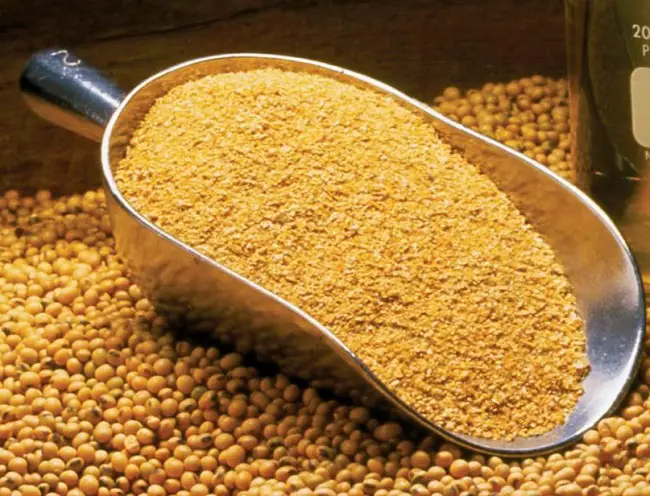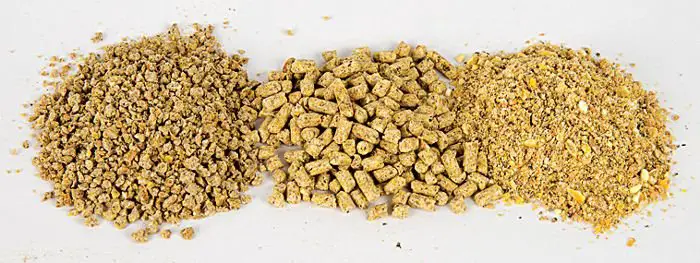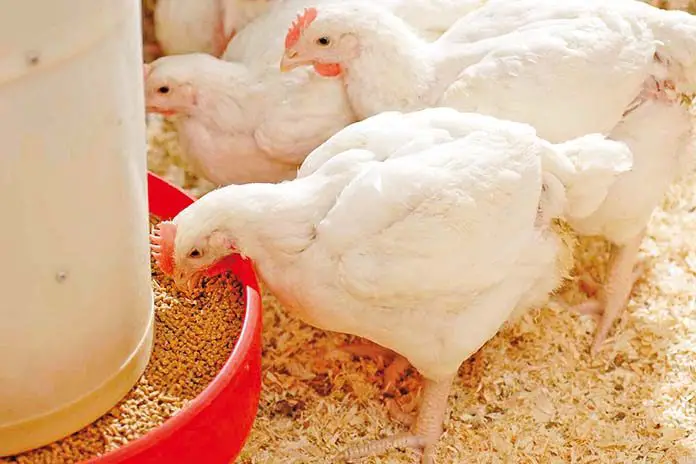Soybean meal is the best protein source for poultry feed and is the benchmark by which other protein sources like sunflower, rapeseed, and cottonseed meal are judged. Soybean meal is a protein-dense raw material averaging 45% crude protein, however, it is limited in the amount of methionine an essential amino acid required by poultry. Feeding soybean meal to poultry does present some challenges regards the performance of poultry due to issues with feed intake and palatability if not properly processed. It is known by quite a number of names depending on the region of the world, from soya bean meal, soybean cake, soybean oil meal, and soybean oil cake. It is estimated that almost half of all the soybean meal produced worldwide goes to the making of poultry feed.
Contents
Processing Soybean Meal
The most common way of processing soybean meal to extract the oil is a process called solvent extraction, by which the soybeans are crushed into flakes and a solvent is used to extract oil from these soybean flakes. Small-scale oil expressers use expeller machines to squeeze out the oil from the soybeans, the press generates but in most cases the beans have to be roasted first before crushing. A combination of extrusion and expelling can also be used to process soybeans into soybean meal good for poultry feed. Solvent extraction is the most efficient method of extracting oil from beans producing a meal with an oil content of about 1.5%.
Soybean Meal Nutritional Attributes
The nutrient profile of the resultant soybean meal depends on the extraction method and any preparations that could have been done to the raw soybeans like dehulling which reduces the fiber content of the resultant meal. The reduction in fiber in the final meal improves the digestion of poultry feed but also improves the crude protein level of the soybean meal. Extrusion has also been shown to free up more fat making the resultant meal after oil expression much higher in energy that solvent extraction.
Table 1: Typical Analysis of Soybean Meal
| Analysis | Unit | Typical % |
| Dry Matter | % as fed | 93.2 |
| Crude Protein | %DM | 47 |
| Gross Energy | MJ/Kg DM | 21.1 |
| Ether Extract | %DM | 9.5 |
| Crude Fibre | %DM | 6.4 |
| Ash | %DM | 6.6 |
| Calcium | G/KG DM | 3.7 |
| Phosphorus | G/KG DM | 6.9 |
Table 2: Standard Amino Acid Digestibility of Soybean Meal in Poultry Feed
The table below shows that soybean meal is superior in digestibility in poultry feed than even animal sources with higher crude protein levels. Soybean meal also contains a high amount of lysine compared to any other plant sources also making it favorable for poultry feed as lysine is an essential amino acid for poultry. Maize and soybean meal are the best combination for making poultry feed as they complement each other very well in terms of being nutrient-dense in energy and protein respectively with very low fiber levels.
| Raw Material | Lysine | Methionine | Threonine |
| Solvent-Extracted Soya Bean Meal | 90 | 92 | 85 |
| Mechanically extracted Soya Bean Meal | 90 | 91 | 85 |
| Cotton Seed Meal | 65 | 72 | 68 |
| Fish Meal | 86 | 86 | 80 |
| Meat and Bone Meal | 69 | 72 | 62 |
| Sunflower meal | 87 | 92 | 82 |
| Maize | 92 | 94 | 85 |
| Wheat Bran | 73 | 80 | 84 |
The amount of soybean meal in poultry feed can be reduced by adding synthetic lysine and methionine to the feed thus reducing the overall cost of the feed.
Quality and Potential Issues
One major attribute of soybean meal that affects how it is used in poultry feed is the presence of anti-nutritional factors called trypsin inhibitors and pectins. The great thing is that these anti-nutritional factors can be easily destroyed by heat. Soybean meal has a high potassium level and its inclusion into poultry feed needs to be adjusted if there is a problem of wet litter in the poultry house.
Soybean Meal in Poultry Feed
Soybean meal is the most commonly used protein source for poultry feed because of the above-mentioned attributes about 98% of all soybean meal produced goes to animal feeding of which poultry take the bulk of it. For other animal species, soybean meal proves not to be not as cost-effective, especially for animals that require low crude protein diets like ruminants. In fish and aquatic feeds which are mostly high protein, soybean meal is blended with animal sources to bring the protein levels to the required levels. The feeding quality of soybean meal improves with the level of heat processing with raw and over-processed soybean meal deemed unsafe for feeding poultry. Various methods, a summary shown below, have been devised to test the level of processing and evaluate the acceptability of soybean meal in poultry diets
Table 3: Methods of Evaluating Level Soybean Meal Processing
| Level of Cooking | Trypsin Inhibitor Activity | Delta pH Urease Test | Cresol Red test | KOH Solubility Test | PDI Test (%) | Recommendation |
| Raw | 50000 | ≥1.5 | Red | ±100 | ≥75 | Unsafe |
| Undercooked | 30000 | 0.3-1.5 | Dark Pink | 85-90 | 45-75 | Use in adult poultry |
| Properly Cooked | 5000-10000 | 0.1-0.3 | Pink | 80-85 | 30-45 | Perfect |
| Toasted | 2000-5000 | 0.05-0.1 | Light Pink | 75-80 | 15-0 | Use in adult poultry |
| Overcooked | ≤2000 | ≤0.5 | Amber | ≤75 | ≤15 | Unsafe |
The protein and energy availability of soybean meal increases with the level of cooking or processing and drops when the soybean meal is over-processed, which means that it is critical to test the quality of the soybean meal before including it in poultry feed.
Alternatives to Soybean Meal in Poultry Feeding
The has been a lot of interest in recent years to move away from soybean meal due to issues with unsustainable production and the bulk of the crop being genetically modified. Most consumers are now conscience of what they consume and novel ingredients like insect protein could slowly replace soybean in poultry feeding.
Soybean meal is, by all means, the perfect protein source for poultry feed, and over the years industries have been built around its production and usage making it also a very cost-effective choice when choosing poultry feed protein sources. It will take some time for alternatives to soybean to reach similar economies of scale for them to dethrone soybean meal as the king of protein sources.




